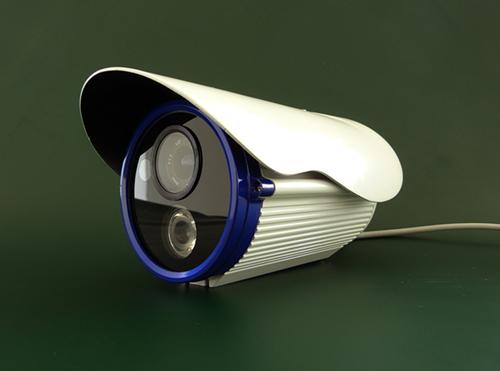 In the video surveillance industry, the hot spots that have emerged in the past two years, apart from the networking represented by the NVR, should be high definition. In fact, for video surveillance, image clarity is indeed the most critical feature. Because the clearer the image, the more detailed the details, the better the viewing experience, and the higher the accuracy of smart and other application services. It can be seen that the introduction of high-definition performance will bring a series of all-round and dramatic improvements to the practical application of video surveillance services. The importance of HD for video surveillance is self-evident.
In the video surveillance industry, the hot spots that have emerged in the past two years, apart from the networking represented by the NVR, should be high definition. In fact, for video surveillance, image clarity is indeed the most critical feature. Because the clearer the image, the more detailed the details, the better the viewing experience, and the higher the accuracy of smart and other application services. It can be seen that the introduction of high-definition performance will bring a series of all-round and dramatic improvements to the practical application of video surveillance services. The importance of HD for video surveillance is self-evident. Since HD surveillance is not yet fully popular, the concept of high-definition in the current market is still vague or even erroneous. Therefore, before elaborating the relationship between high-definition and NVR, we need to first understand some of the core concepts of high-definition surveillance:
1) The front end of HD monitoring must be an HD IP camera
Traditional SD monitoring can be divided into analog, digital, and network types. The front end of these monitoring systems can use analog cameras, network cameras, video encoders, analog cameras, and other types, but in HD monitoring, the front end must be HD IP camera.
First, the uncompressed high-definition video signal after the acquisition has both analog and digital transmission methods. No matter whether it is analog or digital transmission, the transmission cost of uncompressed high-definition video signals will be much higher than the previous analog SD video. The signal, therefore, can see that the transmission of high-definition video signals cannot continue to use the transmission methods of SDTV systems in the past, but can only compress and encode the video and transmit it through the IP network, and adopt this transmission method and the transmission of the SD system. The difference in cost is minimal.
Secondly, because of the high cost performance of CMOS high-definition video sensors, the efficiency and cost of directly using high-definition network cameras for front-end processing are more advantageous than those of high-definition video encoders and high-definition cameras.
2) HDTV HD standard system is the mainstream
After the video resolution of the monitoring device reaches megapixels or 720p, it can be called HD, and in fact, there is still a big difference between megapixel and 720p.
720p is derived from the HDTV standard developed by the Society of Motion Picture and Television Engineers (SMPTE). According to the standard, there are three main formats that truly meet HD video: 720p (1280*720) resolution, 1080i (1920*1080) resolution, and 1080p (1920*1080) resolution. This high-definition video standard originally used in the broadcasting and TV industry has also been commonly adopted by the video surveillance industry as a recognized technical standard.
The megapixel is not a recognized standard, but it actually refers to the number of image sensor elements of the network camera. When a high-definition IP camera has more than megapixel performance, it is still not known what the frame rate of this camera is, how the video aspect ratio is, whether it is interlaced or progressive, how the color fidelity is, and so on. It is also the main indicator of the performance of a high-definition IP camera. Therefore, as an industry standard, it is clear that the HDTV standard is more practical.
3) H.264 will dominate the video coding technology
HD video camera video coding standards are mainly MJPEG and H.264 two. MJPEG (MotionJPEG) is a dynamic image compression technology developed on the basis of JPEG. Although it has certain advantages, its defects are also very obvious, including serious drop frame phenomenon, poor real-time performance, low compression efficiency, and large transmission bandwidth and storage space. .
H.264 is a new-generation video coding standard developed by the joint video work group JVT jointly established by ITU-T and ISO. It not only saves more than 80% of the bit rate of MJPEG, but also has better support for network transmission. As a result, broadcast-quality HD video resolutions of 720p and 1080i/p can be achieved at lower bandwidths.
As mentioned earlier, although NVR has many innovative advantages, the true popularity still needs a core competitive feature to pull, and the high resolution, high fluency, and large-screen and wide-screen display based on the above high-definition technology The ability to dramatically improve the ease of use of the monitoring system and the user's image browsing experience, etc., coincides with the requirements of the NVR's core competencies. At the same time, since the basic premise of high-definition monitoring must be networked, the combination of high-definition and NVR is a matter of course.
Finally, coupled with the excellent quality of NVR itself, including the integrated functions we already know and recognize, including access management, video storage, and decoding, we believe that in the era of high-definition surveillance, NVRs will be able to face unprecedented opportunities for development. .
Sewing Measuring Tape,Tailor Measuring Tape,Custom Logo Tape Measure,Tailor Measuring Soft Tape Measure
Shangqiu Hengli Measuring Tools Co.,Ltd , https://www.henglimtools.com